- Joined
- Jul 27, 2009
- Messages
- 3,864
Reading a diamond report is not as straight forward as you might think! The main reason is that not all relevant information is necessarily contained in a lab report. And much of the information that is contained is rounded and averaged, or stated in ranges, albeit small ones. Learning to interpret some of the indirect information on a lab report is very important in understanding a diamond fully. While not an exhaustive guide, this article will discuss both the basics and some of the more advanced points that even some members of the trade may not be aware of. We will focus on natural diamonds, and on GIA reports as they are considered the gold standard worldwide.
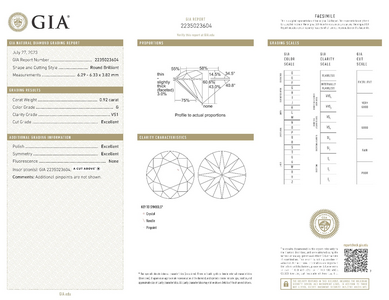
Dimensions and Carat Weight
The only two fully objective measures contained on a diamond report are dimensions and carat weight. Dimensions are measured using highly accurate non-contact measuring devices and carat weight is measured on very sensitive digital scales. That is pretty much where full objectivity ends!
Color and Clarity
Color and clarity grades are actually very small ranges on a continuum. Therefore a diamond could be a borderline Si1 and get a VS2 grade, or almost an H color but receive a grade of I. There is no way to know from the report where the color might lie within the small range of its assigned grade. This is why there is an accepted one grade (+/-) potential variance between top tier laboratories.
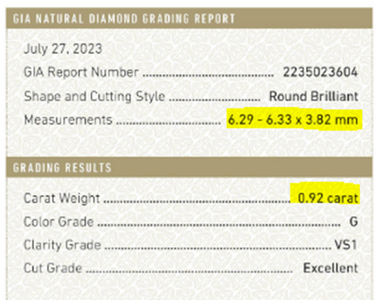
With clarity, there are often additional clues available, especially if it is a full report with a stone plot. * GIA Dossier reports, usually on diamonds under 1.00ct, do not contain a stone plot.
Clarity, also sometimes referred to as purity, is a characteristic based on the presence or absence of inclusions (internal features) and blemishes (surface features) visible to a trained grader observing the stone under 10x magnification. Clarity grading is inherently subjective because every stone is different and there are so many different types of clarity characteristics possible. Assigning a clarity grade depends on how the grader assesses the number, size, type and location of the inclusions. The further down the clarity grading scale you go, the broader the range of diamonds that can fall into each grade.
At the top of the scale are clarities with inclusions that are difficult even for a trained grader working in controlled conditions to see. The differences between FL, IF, VVS1, and VVS2 are so minute that the grades do not have any impact on appearance or performance. These are essentially “rarity” grades. They have an impact on price and value, but not on beauty.
The clarity grade is accompanied by a stone plot – a diagram of the diamond with inclusions and blemishes marked, and creating a map that helps to positively identify a given diamond. It is important to understand that not all features in the diamond are necessarily plotted; only those necessary to support the clarity grade and to help identify the diamond.
The grade-setting inclusion- the inclusion type with the most impact on the clarity grade – is listed first under Key to Symbols. This is important to understand as the plotting itself does not necessarily convey how easy a particular inclusion is to see or how much it may or may not have contributed to the grade. For example, if the stone is graded VS and has multiple inclusion types and the one listed last is feather, it is likely to be insignificant and not raise any concerns for durability.
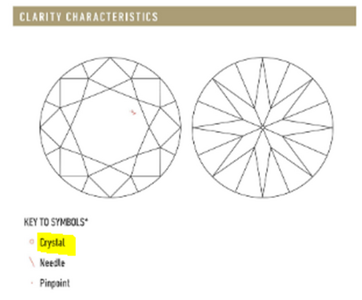
Comments
The Comments section can be a very important part of the report. This is a place where the lab can communicate information not apparent from the grade or even from the stone plot. There can be notations of other inclusions in the stone that are not plotted. There can be an explanation of why a cut grade was lowered that would not be apparent from the proportions, polish, and symmetry data including non-standard “brillianteering”, otherwise known as painting and digging out.
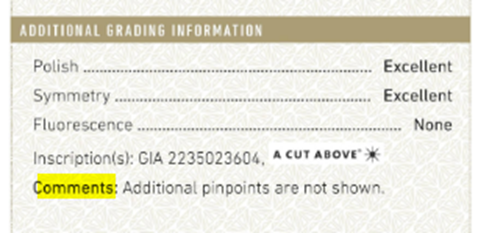
Transparency and Comments
No laboratory yet renders a grade or measurement of transparency. The presence of inclusions and some sub-microscopic features can sometimes negatively impact the ability of light to travel through a diamond. This can sometimes be a subtle effect that results in a diamond being slightly hazy or “sleepy”, lacking the pop that we normally associate with beautiful diamonds. This can diminish the light performance of even the most precisely cut diamond.
One comment that is a red flag for this problem is “clarity grade based on clouds not shown”. In an Si grade, a diamond with this notation will almost invariably have diminished transparency. And the danger for the uninitiated is that such a diamond may have a very clean stone plot and look like the “unicorn” that shoppers are always hoping to stumble upon.
Proportions and Cut Grade
The proportion data that appears on a laboratory report is also objective, but it is the result of averaging and rounding multiple facets. For instance, on a round brilliant the crown angle is a rounded average of the eight bezel facets on the crown (crown mains) and the pavilion angle is the rounded average of the eight pavilion main facets. If the diamond is precisely cut all those facets will be very close to the average. But that is often not the case and more information is needed to determine facet precision and alignment.
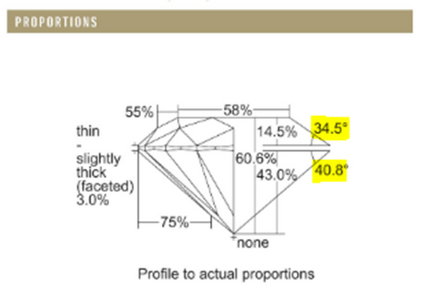
A GIA report for a round brilliant includes a cut grade. At this time no fancy shapes include a cut grade on a GIA grading report. *Note: An AGS Ideal Report by GIA is now available for diamonds that qualify (including some fancy shapes) as a result of GIA’s recent acquisition of AGSL technology. This is likely the first step in implementation of an overall cut grade on GIA fancy shapes.
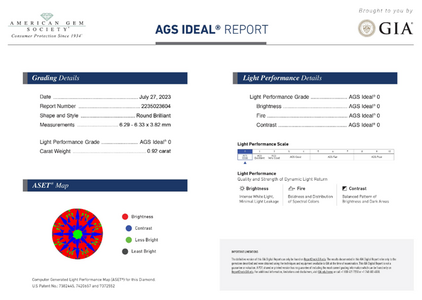
Additional Grading Information
Polish and symmetry are cut related items, specifically cut craftsmanship. They are observations regarding the degree to which the cutter achieved a mirror finish on all the facets, and the degree to which those facets meet up with contiguous facets at the right points around the stone. This is referred to more specifically as “meet point” symmetry, not to be confused with optical symmetry or 3D symmetry, which is the alignment of opposing facets in 3 dimensions. It should be noted that the polish and symmetry grades alone do not tell you much of anything about actual light performance. But they do speak to the care taken by the cutter to get the finish right. On reports of fancy shape diamonds without an overall cut grade there may be tendency to equate Ex/Ex with a top performing diamond. In the absence of addition cut related information such as light performance imaging, it is a mistake to make this assumption.
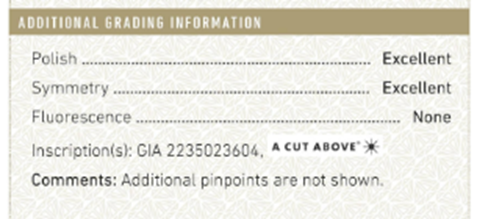
Fluorescence is an important factor that can impact the appearance and/or value of the diamond. Like the color grade it is assessed on a continuum from None to Very Strong. So, a Medium could be borderline Strong or borderline Faint. Strengths greater than faint will have a color associated with them, usually blue. The impacts or potential impacts of fluorescence requires a whole discussion of its own. If you are considering a diamond with strong fluoresce it is recommended that you gain an understanding of this trait to make sure it is right for you.
Conclusion
When GIA first started issuing diamond reports in the 1950’s it was assumed that the consumer would always be physically inspecting the stone together with a jewelry professional who could explain the grading and interpret some of the nuances that the report might be communicating. Today, with so many people shopping for their diamonds online, it is important that consumers themselves can interpret the more subtle aspects of the report. A laboratory report in the era of treated and lab grown diamonds is essential for purchasing any diamond of significant value. It’s also important to understand what a lab report does not tell you, and to learn some of the indirect ways a report communicates additional important information beyond the basic 4 Cs.
Do you have comments or questions about the information provided on a GIA report? Have you seen any notations on a report that puzzled you?

Dimensions and Carat Weight
The only two fully objective measures contained on a diamond report are dimensions and carat weight. Dimensions are measured using highly accurate non-contact measuring devices and carat weight is measured on very sensitive digital scales. That is pretty much where full objectivity ends!
Color and Clarity
Color and clarity grades are actually very small ranges on a continuum. Therefore a diamond could be a borderline Si1 and get a VS2 grade, or almost an H color but receive a grade of I. There is no way to know from the report where the color might lie within the small range of its assigned grade. This is why there is an accepted one grade (+/-) potential variance between top tier laboratories.

With clarity, there are often additional clues available, especially if it is a full report with a stone plot. * GIA Dossier reports, usually on diamonds under 1.00ct, do not contain a stone plot.
Clarity, also sometimes referred to as purity, is a characteristic based on the presence or absence of inclusions (internal features) and blemishes (surface features) visible to a trained grader observing the stone under 10x magnification. Clarity grading is inherently subjective because every stone is different and there are so many different types of clarity characteristics possible. Assigning a clarity grade depends on how the grader assesses the number, size, type and location of the inclusions. The further down the clarity grading scale you go, the broader the range of diamonds that can fall into each grade.
At the top of the scale are clarities with inclusions that are difficult even for a trained grader working in controlled conditions to see. The differences between FL, IF, VVS1, and VVS2 are so minute that the grades do not have any impact on appearance or performance. These are essentially “rarity” grades. They have an impact on price and value, but not on beauty.
The clarity grade is accompanied by a stone plot – a diagram of the diamond with inclusions and blemishes marked, and creating a map that helps to positively identify a given diamond. It is important to understand that not all features in the diamond are necessarily plotted; only those necessary to support the clarity grade and to help identify the diamond.
The grade-setting inclusion- the inclusion type with the most impact on the clarity grade – is listed first under Key to Symbols. This is important to understand as the plotting itself does not necessarily convey how easy a particular inclusion is to see or how much it may or may not have contributed to the grade. For example, if the stone is graded VS and has multiple inclusion types and the one listed last is feather, it is likely to be insignificant and not raise any concerns for durability.

Comments
The Comments section can be a very important part of the report. This is a place where the lab can communicate information not apparent from the grade or even from the stone plot. There can be notations of other inclusions in the stone that are not plotted. There can be an explanation of why a cut grade was lowered that would not be apparent from the proportions, polish, and symmetry data including non-standard “brillianteering”, otherwise known as painting and digging out.

To understand the significance of the comments it is necessary to read the comments in the context of the clarity grade. For instance, a comment such as “clouds not shown” in a VVS diamond will likely have no practical impact. But if comments in an Si2 include additional clouds, twinning wisps, and graining, the report is communicating that there is a chance that the stone has compromised transparency - particularly if the grade-setting inclusion is one of these types.Transparency and Comments
No laboratory yet renders a grade or measurement of transparency. The presence of inclusions and some sub-microscopic features can sometimes negatively impact the ability of light to travel through a diamond. This can sometimes be a subtle effect that results in a diamond being slightly hazy or “sleepy”, lacking the pop that we normally associate with beautiful diamonds. This can diminish the light performance of even the most precisely cut diamond.
One comment that is a red flag for this problem is “clarity grade based on clouds not shown”. In an Si grade, a diamond with this notation will almost invariably have diminished transparency. And the danger for the uninitiated is that such a diamond may have a very clean stone plot and look like the “unicorn” that shoppers are always hoping to stumble upon.
Proportions and Cut Grade
The proportion data that appears on a laboratory report is also objective, but it is the result of averaging and rounding multiple facets. For instance, on a round brilliant the crown angle is a rounded average of the eight bezel facets on the crown (crown mains) and the pavilion angle is the rounded average of the eight pavilion main facets. If the diamond is precisely cut all those facets will be very close to the average. But that is often not the case and more information is needed to determine facet precision and alignment.

A GIA report for a round brilliant includes a cut grade. At this time no fancy shapes include a cut grade on a GIA grading report. *Note: An AGS Ideal Report by GIA is now available for diamonds that qualify (including some fancy shapes) as a result of GIA’s recent acquisition of AGSL technology. This is likely the first step in implementation of an overall cut grade on GIA fancy shapes.

The GIA Excellent cut grade for rounds is known to be quite broad and forgiving. Customers looking for precision cut diamonds need additional information such as light performance imaging in order to reveal any issues that might be present because of poor facet precision. With fancy cuts because of their higher degree of complexity in terms of the interaction of all their facets, a GIA report provides very little actionable guidance about appearance and light performance.Additional Grading Information
Polish and symmetry are cut related items, specifically cut craftsmanship. They are observations regarding the degree to which the cutter achieved a mirror finish on all the facets, and the degree to which those facets meet up with contiguous facets at the right points around the stone. This is referred to more specifically as “meet point” symmetry, not to be confused with optical symmetry or 3D symmetry, which is the alignment of opposing facets in 3 dimensions. It should be noted that the polish and symmetry grades alone do not tell you much of anything about actual light performance. But they do speak to the care taken by the cutter to get the finish right. On reports of fancy shape diamonds without an overall cut grade there may be tendency to equate Ex/Ex with a top performing diamond. In the absence of addition cut related information such as light performance imaging, it is a mistake to make this assumption.

In addition to the polish and symmetry grades, this section also includes a fluorescence rating and any inscriptions that may be laser engraved on the girdle. The inscription usually consists of the report number but also may include other characters including brand names and logos.Fluorescence is an important factor that can impact the appearance and/or value of the diamond. Like the color grade it is assessed on a continuum from None to Very Strong. So, a Medium could be borderline Strong or borderline Faint. Strengths greater than faint will have a color associated with them, usually blue. The impacts or potential impacts of fluorescence requires a whole discussion of its own. If you are considering a diamond with strong fluoresce it is recommended that you gain an understanding of this trait to make sure it is right for you.
Conclusion
When GIA first started issuing diamond reports in the 1950’s it was assumed that the consumer would always be physically inspecting the stone together with a jewelry professional who could explain the grading and interpret some of the nuances that the report might be communicating. Today, with so many people shopping for their diamonds online, it is important that consumers themselves can interpret the more subtle aspects of the report. A laboratory report in the era of treated and lab grown diamonds is essential for purchasing any diamond of significant value. It’s also important to understand what a lab report does not tell you, and to learn some of the indirect ways a report communicates additional important information beyond the basic 4 Cs.
Do you have comments or questions about the information provided on a GIA report? Have you seen any notations on a report that puzzled you?




300x240.png)